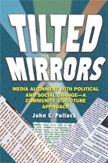Tilted Mirrors: Media Alignment with Political and Social Change (John Pollock) | |
|  | Quantity in Basket:none
Code: 1-57273-660-7
Price:$85.00
Title: Tilted Mirrors
Sub-title: Media Alignment with Political and Social Change-A Community Structure Approach
Author(s): John Pollock
Publish Date: September 2007
Pages: 360
Format: Cloth
| |
| Instead of examining the impact of media on society, this book explores the impact of society on media. How do communities affect the way media build different issue perspectives or frames? Introducing an unusual composite "Media Vector" score, the book adopts a unique "community structure" approach, using modern national databases to link selected city characteristics and nationwide newspaper reporting on critical issues. Several media frame-building patterns emerge. The "Buffer Hypothesis" connects larger proportions of privileged groups "buffered" from economic uncertainty in cities to more favorable reporting on human rights claims or scientific advances (e.g., Anita Hill, physician-associated suicide and embryonic stem cell research). Other frame-building patterns--Violated Buffer, Vulnerability, Protection and Stakeholder--also illuminate critical issues (e.g., banning smoking advertising to children, the Supreme Court stopping presidential vote counting in 2000, capital punishment, Patient's Bill of Rights, gun control, Arctic oil drilling, trying juveniles as adults, gays in the Boy Scouts, and those with HIV/AIDS).
Positioned at the crossroads of communication/journalism, political science and sociology disciplines, this book is an innovative supplemental text for courses in mass media, media effects, communication or journalism research methods, political communication or sociology of communication.
"John Pollock's impeccable study is a terrific piece of research. Tilted Mirrors belongs on the bookshelf of anyone who wants to know how the press in America truly operates. Pollock's unsettling findings go far beyond previous work in illuminating the relationship between a community and its daily paper, forcing journalists to rethink comfortable assumptions and requiring faculty to revise the way they teach and write about the press."
~Thomas E. Patterson, Harvard University
"John Pollock's Tilted Mirrors book enters a new theoretical and methodological domain in explaining media content on politics and public affairs. His "community structure approach" seeks explanations for journalists' news decisions in the wider social structure of the community, conceptualizing the local newspaper as a "community institution," not--as is the case in most other approaches--as a professional world of its own. Unlike most community case studies, this methodological innovation of this book lies in samples of multiple cities and newspapers."
~Wolfgang Donsbach, Dresden University of Technology
"Community structure analysis holds great promise for media and public policy research, and John Pollock's elaboration of the concept transforms the notion of "community pluralism" into a well grounded and empirically validated approach toward understanding the ways in which power actually operates on and through the press, helping to reveal the ways interests, positions of privilege and status among key stakeholders work together to determine how issues will be framed in different communities."
~Oscar H. Gandy, University of Pennsylvania
Contents: Introduction. SECTION I: COMMUNITY STRUCTURE APPROACH AND MEDIA ALIGNMENT. The Community Structure Approach and Newspaper Framing of Critical Events. Measuring Media Alignment: The Challenge of Nationwide Samples, a Single Score "Media Vector" and Key Umbrella Hypotheses. SECTION II: FIVE UMBRELLA HYPOTHESES AND CASE STUDIES. The "Buffer" Hypothesis: Privilege Linked to Favorable Reporting on Human Rights Claims. The Violated Buffer Hypothesis: Privilege Linked to Unfavorable Reporting on Threats to Existence or a Way of Life. The Vulnerability Hypothesis: Greater Proportion of Vulnerable Citizens Linked to Favorable Coverage of Critical Issues. The Economic "Protection" Hypothesis. The "Stakeholder" Hypothesis: Higher Proportions of Issue Stakeholders are Linked to Favorable Coverage. SECTION III: SHIFTING FRAMES, MULTIPLE METHODOLOGIES AND FUTURE RESEARCH. Shifting Coverage of Those with HIV/AIDS (Ryan White to 1995): Turning the Pendulum of Privilege. Converging Explanations for Coverage of Homosexuals in The Boy Scouts of America: Community Structure, Public Opinion and Ownership Patterns. Tilted Mirrors: Media Alignment with Social Control and Social Change. Epilogue: Community Structure Predictions, Constraints and Uses. References. Author Index. Subject Index. |
| |







